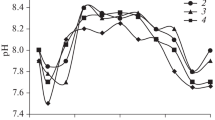Abstract
Food wastewater contains abundant nutrition substances causing high biological load on the environment. Inorganic and organic synthetic high-polymer flocculants have been most commonly used because of their flocculating efficiency and low cost. Natural organic flocculants possess a certain synthetic advantage. To investigate the optimal flocculant for food wastewater treatment, effects of five organic and chemical flocculants, being Chitosan (CTS), Polyaluminum sulfate (PAS), Polyaluminium chloride (PAC), Polyaluminum ferric silicate (PSAF), Polyacrylamide (PAM) and their pair composite flocculants by stirring have been studied. Under the condition of 300 rpm for 30 min by magnetic stirring apparatus, the optimal dosages of PSAF, CTS, PAC, PAM and PAS were 3.30, 2.19, 5.69, 6.56, and 3.30%, respectively. Therefore, effect of CTS was optimal because of its 87.24% maximal absorbance reduction. CTS demonstrates biodegradability and antibacterial activity, and the hydrophilicity introduced by the addition of polar groups is able to develop secondary interactions (–OH and –NH2 groups involved in H bonds with other polymers), which results in its excellent flocculant property. The optimal proportions of two components in composite flocculant A (CTS-PSAF), B (PAC-PAM), C (P SAF-PAC), D (PAS-PAM), E (CTS-PAS), F (CTS-PAM) were respectively determined as 0.53, 0.87, 0.46, 0.40, 1.33, and 1.67. Correspondingly, the optimal stirring speeds of every composite flocculant were 20, 20, 125, 125, 160, and 20 rpm. Thus, composite flocculant A was optimal due to 42.89% maximal CODCr removal efficiency and 51.54% maximal BOD5 removal efficiency (CODCr—chemical oxygen demand determined by potassium dichromate method). The results have presented that CTS and its pair flocculants CTS-PSAF are effective for food wastewater treatment, indicating that CTS-based flocculants exhibit effective pollution removal ability with wide applications.




Similar content being viewed by others
REFERENCES
Yang, R., Li, H., Huang, M., Yang, H., and Li, A., A review on chitosan-based flocculants and their applications in water treatment, Water Res., 2016, vol. 95, pp. 59–89.
Wang, C.M., Liu, S., and Yu, H.L., Composite flocculant preparation and application in manure wastewater treatment, J. Residuals Sci. Technol., 2017, vol. 14, no. 2, pp. 137–142.
Li, H. and Pan, G., Simultaneous removal of harmful algal blooms and microcystins using microorganism-and chitosan-modified local soil, Environ. Sci. Technol., 2015, vol. 49, no. 10, pp. 6249–6256.
Dao, V.H., Cameron, N.R., and Saito, K., Synthesis, properties and performance of organic polymers employed in flocculation applications, Polym. Chem., 2016, vol. 7, no. 1, pp. 11–25.
Razali, M.A.A., Ahmad, Z., Ahmad, M.S.B., and Ariffin, A., Treatment of pulp and paper mill wastewater with various molecular weight of polyDADMAC induced flocculation, Chem. Eng. J., 2011, vol. 166, pp. 529–535.
Wang, C.M., Gao, Y.H., Li, C.M., Zhang, Q.L., and Shen, W.B., Research on composite flocculant improving substrate sludge dehydration, Adv. Mater. Res., 2013, vol. 663, pp. 277–281.
Rinaudo, M., Pavlov, G., and Desbrières, J., Influence of acetic acid concentration on the solubilization of chitosan, Polymer, 1999, vol. 40, pp. 7029–7032.
Jiang, J.Q., The role of coagulation in water treatment, Curr. Opin. Chem. Eng., 2015, vol. 8, pp. 36–44.
Zhu, C., Liu, F., Zhang, Y., Wei, M., Zhang, X., Ling, C., and Li, A., Nitrogen-doped chitosan-Fe(III) composite as a dual-functional material for synergistically enhanced co-removal of Cu(II) and Cr(VI) based on adsorption andredox, Chem. Eng. J., 2016, vol. 306, pp. 579–587.
Albadarin, A.B., Collins, M.N., Naushad, M., Shirazian, S., Walker, G., and Mangwandi, C., Activated lignin-chitosan extruded blends for efficient adsorption of Methylene Blue, Chem. Eng. J., 2017, vol. 307, pp. 264–272.
Zheng, H., Sun, Y., Guo, J., Li, F., Fan, W., Liao, Y., and Guan, Q., Characterization and evaluation of dewatering properties of PADB, a highly efficient cationic flocculant, Ind. Eng. Chem. Res., 2014, vol. 53, pp. 2572–2582.
Sun, Y., Ren, M., Zhu, C., Xu, Y., Zheng, H., Xiao, X., Wu, H., Xia, T., and You, Z., UV-initiated graft copolymerization of cationic chitosan-based flocculants for treatment of zinc phosphate-contaminated wastewater, Ind. Eng. Chem. Res., 2016, vol. 55, pp. 10025–10035.
Oyervides-Muñoz, E., Pollet, E., Ulrich, G., de Jesus Sosa-Santillan, G., and Averous, L., Original method for synthesis of chitosan-based antimicrobial agent by quaternary ammonium grafting, Carbohyd. Polym., 2017, vol. 157, pp. 1922–1932.
Petzold, G. and Schwarz, S., Polyelectrolyte complexes in flocculation applications, Adv. Polym. Sci., 2014, vol. 256, pp. 25–66.
Prashanth, K.V.H. and Tharanathan, R.N., Chitin/chitosan: Modifications and their unlimited application potential. An overview, Trends Food Sci. Technol., 2007, vol. 18, pp. 117–131.
Bhatia, S.C. and Ravi, N., A magnetic study of an Fe-chitosan complex and its relevance to other biomolecules, Biomacromolecules, 2000, vol. 1, pp. 413–417.
Wan, C., Alam, M.A., Zhao, X.Q., Zhang, X.Y., Guo, S.L., Ho, S.H., Chang, J.S., and Bai, F.W., Current progress and future prospect of microalgal biomass harvest using various flocculation technologies, Bioresour. Technol., 2015, vol. 184, pp. 251–257.
Li, X., Zheng, H., Gao, B., Sun, Y., Liu, B., and Zhao, C., UV-initiated template copolymerization of AM and MAPTAC: Microblock structure, copolymerization mechanism, and flocculation performance, Chemosphere, 2017, vol. 167, pp. 71–81.
Sperling, L.H., Introduction to Physical Polymer Science, Hoboken: Wiley, 2006, 4th ed.
Funding
This work was supported by Guangzhou Municipal Science and Technology Bureau livelihood project (201903010084), Guangdong Education Department project (2021ZDZX4045), Science and Technology Planning Project of Guangdong Province, China (2021B1212040008).
Author information
Authors and Affiliations
Corresponding author
Ethics declarations
The authors declare that they have no conflicts of interest.
About this article
Cite this article
Chunming Wang, Huang, Z., Lee, X. et al. Screening of Composite Flocculants for Food Wastewater Treatment. J. Water Chem. Technol. 44, 88–95 (2022). https://doi.org/10.3103/S1063455X22020102
Received:
Revised:
Accepted:
Published:
Issue Date:
DOI: https://doi.org/10.3103/S1063455X22020102




